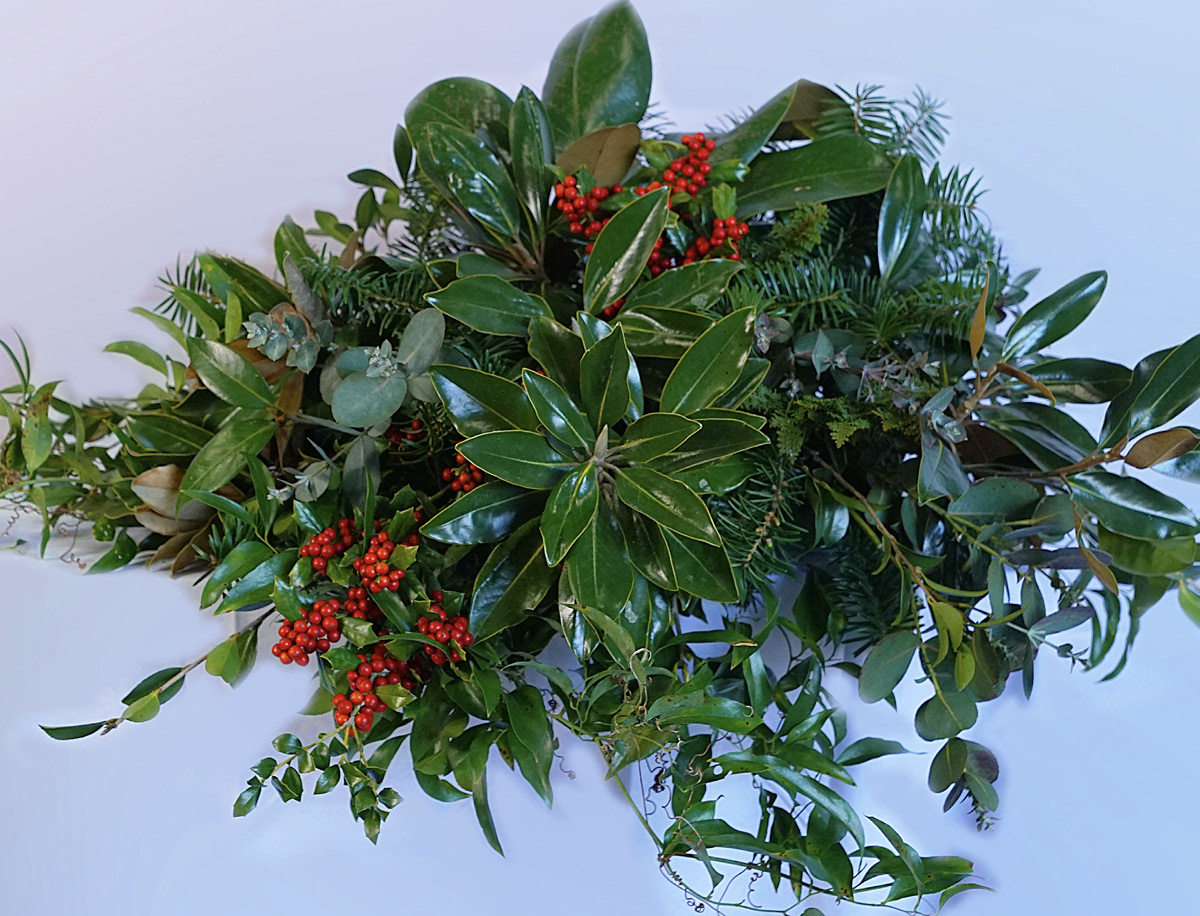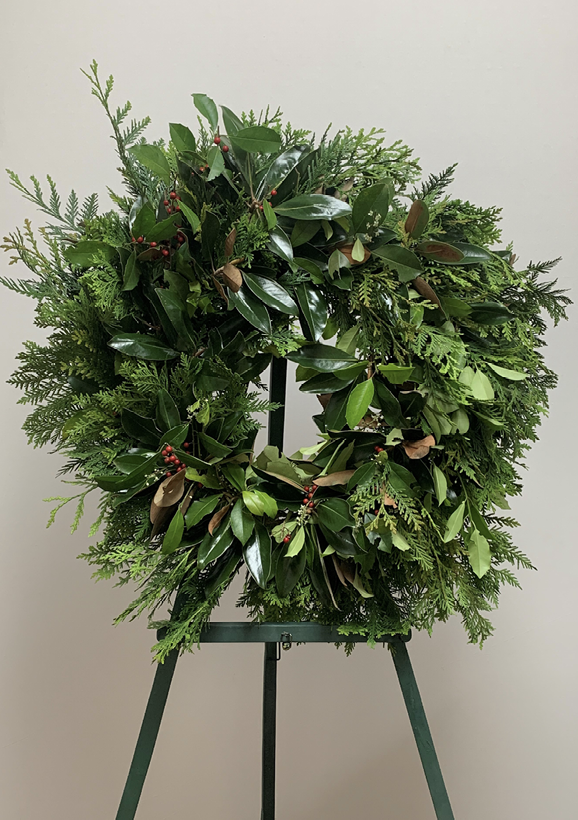Mississippi-Grown Evergreens in Winter Sympathy Designs for the Professional Florist
Mississippi and other Southeastern florists and decorators have a wealth of beautiful cut foliage growing nearby but often overlook harvesting and selling it in floral designs. Growing Southern foliage is relatively simple. Once these plants have roots, extra irrigation and fertilization is not necessary, but growers can base fertilizer regimens on the amount of material needed to meet sales goals.
Growing Southern greenery is a task best accomplished by farmers and farmer florists who are committed for the long haul. After 3 to 4 years, and in some cases earlier, the plants are ready for their first, small harvest. Consider harvesting every third or fourth year instead of annually.
For the designs in this publication, we used evergreens grown and harvested at the MSU South Mississippi Branch Experiment Station in Poplarville. For a recommendation of evergreens suitable for cut foliage, see The Promise of Good Things, published by MSU Extension and available through Amazon.
Christmas tree growers can grow these plants on their farms, increasing revenue and opening the possibility of marketing to different sectors, such as wholesale or retail florists. Retail florists with some land can grow their own durable cut foliage for floral designs. Farmer florists should consider adding woody evergreens to their product mix. Mississippi-grown evergreens stand out among those from northern states (salal, huckleberry) or imported foliage (jade, commodore).
Consider growing, purchasing, marketing, and selling our local, durable foliage for sympathy floral designs during the winter season. Doing so promotes local floriculture, reduces your carbon footprint, saves money, and provides consumers with unique, durable, and beautiful products.
Standing Spray

In this design, we used a fresh floral foam cage mechanic (Smithers Oasis in Kent, Ohio) measuring 4.25 inches long, 6.75 inches wide, and 3.25 inches tall, attached to a wire easel. The recommended practice for securing this mechanic is to use three points of attachment, wiring the cage to the side legs and the upper eye of the easel. Use florist wire, chenille stems, cable ties, or other products to secure the cage to the stand.
The spray contains southern smilax (Smilax smallii), holly (Ilex x ‘Conin’), Little Gem magnolia (Magnolia grandiflora ‘Little Gem’), and momi fir (Abies firma). Designers can add cut flowers, ribbon, pine cones, or other trims to this spray to increase its retail value. The beauty of the fresh foliage and contrast of leaf textures would make this arrangement stand out at a visitation or service.
Many customers would appreciate the gentle beauty of Southern evergreens. Florists and producers can make these arrangements and store them in refrigeration (33–38ºF and 90 percent relative humidity) for weeks. Southern evergreens are durable and long-lasting when kept moist and cool.
Half-Couch Casket Spray

A lovely adornment for a casket, this half-couch casket spray uses a commercially prepared casket saddle with an attached floral foam cage (FloraCraft in Ludington, Michigan). All we needed to do was free-float soak the unit, then add evergreens. Large mechanics such as these work well to create fireplace mantels and hearth arrangements, too. Retailers should consider marketing similar designs using saddle mechanics that clamp to cemetery tombstones.
This arrangement uses southern smilax (Smilax smallii), holly (Ilex x attenuata ‘Savannah’), Little Gem magnolia (Magnolia grandiflora ‘Little Gem’), eucalyptus (Eucalyptus neglecta), and momi fir (Abies firma). Like the standing spray, designers can add flowers and/or trims to the design to customize the arrangement and add value.
Evergreen Wreath

Clamp-type machines are indispensable for the manufacture of fresh evergreen wreaths. This design was made with a clamping wreath machine and an associated 14-inch-diameter wire frame (Mitchell Wreath Rings in Merrill, Wisconsin). A combination of Leyland cypress (x Cuprocyparis leylandii), Green Giant arborvitae (Thuja occidentalis), and Savannah holly (Ilex x attenuata ‘Savannah’) were gathered in bunches, then each bunch was clamped into the wreath frame.
This process was repeated to round out the design. The finished wreath, approximately 24 inches in diameter, was wired to a wooden stand using three points of attachment for stability. Additional trims such as pine cones, twigs, or other materials found on the farm or in florist shop inventory could be added to this design to increase its retail value.
This wreath would be an honorable, loving tribute to a family member or loved one. It is traditional yet unusual and will be prominent in a room containing the customary standing sprays. It will remain fresh and beautiful while on display at the cemetery for many weeks or months in cool weather. A benefit of this design is that it can remain on the grave, acting as a temporary marker until a permanent tombstone is installed.
References
Butler, S., DelPrince, J., Fowler, C., Gilliam, H., Johnson, J., McKinley, W., Money-Collins, H., Moss, L., Murray, P., Pamper, K., Scace, P., Shelton, F., Verheijen, A., & Whalen, K. (2008). The AIFD guide to floral design. Intelvid.
DelPrince, J., Knight, T., Coker, C., & Stephenson, C. (2021). The promise of good things. Mississippi State University Extension Service.
Dirr, M. (2009). Manual of woody landscape plants (6th ed.). Stipes.
Hunter, N. (2013). The art of floral design (3rd ed.). Delmar Cengage.
Johnson, J., McKinley, W., & Benz, B. (2001). Flowers: Creative design. San Jacinto.
Nowak, J. & Rudnicki, R. M. (1990). Postharvest handling and storage of cut flowers, florist greens, and potted plants. Timer Press.
Posadas, B. & DelPrince, J. (2019). Consumer preferences and willingness to pay for wreath designs. Bulletin 1227. Mississippi Agricultural and Forestry Experiment Station.
Scace, P. D., & DelPrince, J. (2020). Principles of floral design (2nd ed.). Goodheart-Willcox.
Wood, M. (2007). The seasonal home. Winward.
The information given here is for educational purposes only. References to commercial products, trade names, or suppliers are made with the understanding that no endorsement is implied and that no discrimination against other products or suppliers is intended.
Publication 3775 (POD-06-22)
By James M. DelPrince, PhD, AIFD, PFCI, Associate Extension Professor, Coastal Research and Extension Center; Jenny Ryals, Research Associate, South Mississippi Branch Experiment Station; Anthony Bowden, Research Associate, South Mississippi Branch Experiment Station; Haley Williams, Agricultural Technician, South Mississippi Branch Experiment Station; Christine Coker, PhD, Associate Extension/Research Professor, Coastal Research and Extension Center; and Patricia Knight, PhD, Research Professor and Director of Coastal Horticulture Research.
The Mississippi State University Extension Service is working to ensure all web content is accessible to all users. If you need assistance accessing any of our content, please email the webteam or call 662-325-2262.


